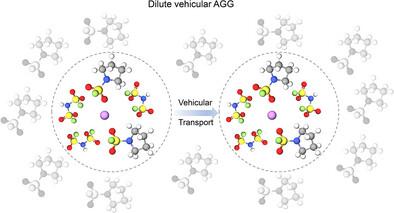Dilute Electrolyte with Vehicular Aggregates for Stable High-Energy Lithium-Metal Batteries
IF 26.8
1区 材料科学
Q1 CHEMISTRY, MULTIDISCIPLINARY
引用次数: 0
Abstract
Electrolyte design is critical for high-energy lithium-metal batteries (LMBs) because it dictates the aggressive Li–electrolyte interphase that governs cycling stability and Coulombic efficiency (CE). However, traditional high- or locally high-concentration electrolytes, which achieve good Li-metal compatibility by the formation of anion‒solvent‒Li+ aggregates (AGG), typically suffer from poor ionic conductivity (e.g., ≈1 mS cm−1). Therefore, achieving both high ionic conductivity and AGG-dominated solvation structure under dilute conditions still remains a challenge. Herein, a novel dilute electrolyte with vehicular aggregates (DVA) mechanism is proposed by employing pyrrolidine-1-sulfonyl fluoride (PSF) solvent with optimal steric hindrance effect. Based on this DVA electrolyte, the uniquely AGG-dominated solvation structure under dilute conditions achieve high ionic conductivity (4.9 mS cm−1) featuring its vehicular ion-transport mechanism. It exhibits good Li-metal compatibility with high stripping-plating CE of ≈99.5% with inorganic (LiF, Li2O)-rich robust solid‒electrolyte interphase. Furthermore, the electrolyte effectively suppresses the stress-corrosion cracking, transition-metal dissolution, gas evolution, and detrimental surface degradation on the cathode side, thus enabling 4.6-V-class LMBs with ultra-high-Ni cathodes to deliver a high discharge capacity of 228.4 mAh g−1, excellent rate capability up to 2C, and 87% capacity retention after 150 cycles. This work offers a promising approach for designing advanced electrolytes for high-energy LMBs.

车用聚集体稀电解质用于稳定高能锂金属电池
电解质设计对于高能锂金属电池(lmb)至关重要,因为它决定了锂-电解质界面的侵略性,而锂-电解质界面决定了循环稳定性和库仑效率(CE)。然而,传统的高浓度或局部高浓度电解质,通过形成阴离子溶剂- li +聚集体(AGG)来实现良好的锂金属相容性,通常具有较差的离子电导率(例如≈1 mS cm−1)。因此,在稀释条件下实现高离子电导率和agg主导的溶剂化结构仍然是一个挑战。本文以具有最佳位阻效应的吡咯烷-1-磺酰氟(PSF)为溶剂,提出了一种具有车辆聚集体(DVA)机理的新型稀电解质。基于该DVA电解质,其独特的agg主导溶剂化结构在稀释条件下实现了高离子电导率(4.9 mS cm−1),具有车辆离子传输机制。它具有≈99.5%的高剥离镀CE和富无机(LiF, Li2O)坚固的固-电解质界面相,具有良好的锂金属相容性。此外,该电解质有效地抑制了阴极侧的应力腐蚀开裂、过渡金属溶解、气体析出和有害的表面降解,从而使具有超高镍阴极的4.6 v级lmb具有228.4 mAh g - 1的高放电容量,高达2C的优异速率容量,在150次循环后保持87%的容量。这项工作为设计高能lmb的先进电解质提供了一种有前途的方法。
本文章由计算机程序翻译,如有差异,请以英文原文为准。
求助全文
约1分钟内获得全文
求助全文
来源期刊

Advanced Materials
工程技术-材料科学:综合
CiteScore
43.00
自引率
4.10%
发文量
2182
审稿时长
2 months
期刊介绍:
Advanced Materials, one of the world's most prestigious journals and the foundation of the Advanced portfolio, is the home of choice for best-in-class materials science for more than 30 years. Following this fast-growing and interdisciplinary field, we are considering and publishing the most important discoveries on any and all materials from materials scientists, chemists, physicists, engineers as well as health and life scientists and bringing you the latest results and trends in modern materials-related research every week.
 求助内容:
求助内容: 应助结果提醒方式:
应助结果提醒方式:


